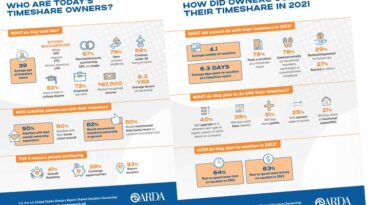3 Things a Resort MUST do to Generate Leads in the Digital Age
Times are a-changing. So are the attention spans and needs of the travel consumer. As such, the tools and methods required to turn those consumers into timeshare owners are also changing — fast. Here, we look at modern, sustainable ways to generate qualified leads in the digital age — leads who are even more qualified than what we’ve become used to and may even feel motivated to become an owner without the sales pitch.
Introduction
Technology offers better access and transparency to nearly every purchase. Choosing where and when you want to go on vacation — and for how much — has gotten easier, and choices have become more abundant. Fifteen years ago, to find a place to stay on vacation with multiple bedrooms and a kitchen, you either needed to:
- Own a vacation home
- Have the budget to book expensive hotel suites
- Own a timeshare
For most people, the first two were extremely price-prohibitive, setting the stage for the third option and timeshare ownership’s true value proposition. Nowadays, almost anyone, regardless of budget, can book a vacation home online and enjoy the perks of added space and the conveniences of home. At the same time, the price barrier for branded timeshare ownership (and its associated usage costs) has increased significantly. In other words, timeshares are simultaneously becoming more expensive and less necessary. Regardless, timeshares remain a popular vacation option despite this trend line. That’s because there are less tangible (more emotional) elements of timeshare vacationing that still deliver. Developers should lean on core emotional value propositions and learn where they can extract those to generate new leads.

Here are three ways to do that:
1. Digital Marketing
Visually stunning and engaging content drives much of the consumer economy today. It’s also the best tool for successful digital marketing campaigns. We always say, “let our users take a vacation before their vacation.” We want their experience to be as immersive as possible. Most vacation clubs still do most of their sales during a live presentation. And if you’re curious about ownership, engaging information and content is difficult to find online. To the consumer who does their travel research online — which is to say 99.9% of them — the timeshare industry remains very enigmatic. To others, it’s a dinosaur. I think that’s a shame because the resorts and experiences they provide are incredible and should be resonating more with the general public than they are.
The lack of digital content is a missed opportunity to build strong demand in advance — or even generate sales. Content that features visually stunning resort videos and images showcases the enviable lifestyle one could have by becoming a member. FOMO (fear of missing out) is everyone’s favorite emotionally magnetic, and highly effective form of marketing.
What resorts rely on instead is a sales process that is often high-pressure and always expensive. Traditional sales and marketing for timeshare cost developers up to 45% of the sales price, a high operating cost that gets baked into the price of the ownership. That inflated purchase price then gets quickly slashed by 80% or more on the secondary market, which then makes it harder for its buyer to recoup anything close to their initial investment. This notorious illiquidity creates a lot of friction at the point of sale and this ominous cycle repeats itself. I believe this to be an untenable form of growth, and timeshare developers should look to these new forms of digital marketing to enhance awareness and interest and drive in-person sales and marketing costs down.
Good digital marketing focused on key value propositions (both emotional and logical buying motives) will change the game by offering targeted, high-quality aspirational marketing content that draws potential customers into the product right away. And not just videos of how beautiful the resorts are (they are!) but how you and your family will feel as a member. Timeshare companies have yet to adopt these marketing funnels.
In contrast, adjacent newcomers like Inspirato and Pacaso are leaning into these principles, and seeing tremendous growth as a result, particularly among younger demographics where the traditional timeshare is struggling. If traditional timeshare companies don’t adopt better digital marketing, they are likely to be outperformed by these newcomers and others like them over time.
Related: The Rise of the Secondary Timeshare Market

2. Virtual Sales
Seriously, the cat’s out of the bag. These in-person sales presentations are generally not fun for vacationers. That said, it’s likely that timeshare developers will still need to do some form of face-to-face sales for the time being because they’re very effective. So, if we’re going to continue these, let’s at least optimize them for the digital age.
One way resorts can reduce friction is to embrace virtual presentations. I believe, that as the industry evolves, more people will be willing to do these than the traditional face-to-face. Plus, the world is shifting to remote…everything, and there are amazing virtual conference tools available to create a better experience. During the pandemic, many vacation clubs implemented this to great success. They were able to maintain strong sales throughout the pandemic while others – who did not pivot – saw their sales suffer greatly until they were able to reopen their sales galleries.
What made this form of virtual selling so effective? First, it was done right after the stay. People still had the post-trip glow but were not resentful about losing two (ok…four) hours of their vacation. Second, I believe that when prospects are in the comfort of their own home, they’re more relaxed and thus more open to hearing an offer. Note: Adaptable closing techniques will be key here, as the traditional day-only sale may be more of a challenge in this format. Developers should understand how to deploy a targeted digital marketing strategy alongside this to increase excitement, organic demand, and most importantly, VPG.
Why now? Timeshare marketing was already tricky pre-pandemic. In my sales days, I often saw two cohorts of prospects. The ones who will do them over and over for the gift or discounts, and the ones who will never ever do them. Many travelers just didn’t want to disrupt their vacations with a long sales presentation, which meant we weren’t getting in front of very sensible people who may have been a great fit for membership. The other cohort had seen the offer so many times, that there was nothing you could say to motivate them to buy — they just wanted the gift. Virtual presentations could dramatically increase conversions to the first cohort and will reduce wasted costs for the second.
3. Owner Rentals
OK, we knew this part was coming. But aside from this being a shameless plug for my company KOALA (which enables timeshare owners to easily rent to travelers), I also genuinely feel this is an important and effective means of lead gen — and the data supports it. Our internal surveys indicate that current owners are more than 3X more likely to upgrade after they discover KOALA and our timeshare rental community. Further, up to 80% of vacationers booking with us don’t own a timeshare — which means there is a lot of opportunity for new owner growth.
While the timeshare industry (mostly) tolerates owner rentals, it certainly doesn’t embrace or even endorse them. It generally sees owner rentals as a nuisance instead of a marketing opportunity. On a logistical level, this makes sense – rental has been an unregulated and confusing process long plagued with opportunism and scams that the resort operators (or scammed owners) are left to deal with. But the irony is that it continues to remain a black market because it’s not blessed by the industry. This lack of endorsement continues to surprise me as it’s a clear and powerful way to generate new leads.
Related: Timeshare Rentals: Put Your Best Foot Forward
I recently wrote a piece on-demand driving supply. This is a proven growth loop used by mega-unicorns like Uber, Airbnb, and Shopify. The premise is simple: Someone engages with the product initially as a buyer (demand) and loves it so much that they elect to participate as a supplier to the marketplace (supply). Uber-rider-becomes-driver, Airbnb-guest-becomes-host, and so on.
Moreover, putting more (and newer) heads in beds leads to more user-generated content showcasing the joys of resort life, which helps the resort sell itself (see Digital Marketing, above). Potential buyers expect to see that kind of content and will be looking for it as part of their purchase journey.
More importantly, the loop drives growth because it’s connected directly to user satisfaction. Both sides of the loop find tremendous value while also putting highly qualified leads in their rooms. The developers that create partners instead of adversaries from the platforms managing owner rental transactions will benefit greatly. Sounds like a no-brainer, doesn’t it?
The digital age is here, and the pandemic only accelerated online buying trends for everything, even major purchases like real estate. Adapting some or all of these principles will help the timeshare industry adapt to the way consumers think these days. Getting the timeshare industry on the digital train (the locomotive, not the caboose) is one of the best ways to stay ahead of the emerging market and make the next generation of travelers the best leads.
Mike Kennedy is CEO and co-founder of KOALA, a new timeshare rental marketplace. Before co-founding KOALA, Mike spent over ten years as a top sales executive for Hilton Grand Vacations, where he first envisioned a secure, easy, and ethical way for timeshare owners to rent their unused time. His long-term mission is to transform the way people take vacations.



